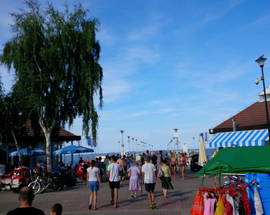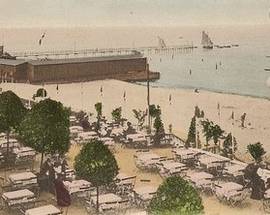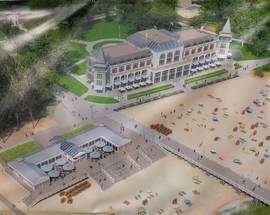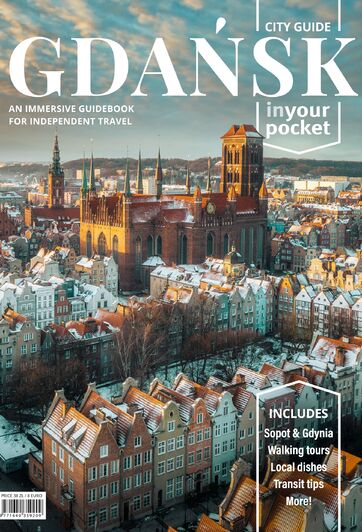Brzeźno
Brzeźno or Brösen as it was known by the Germans was for many years the beach retreat of Danzig (Gdansk) residents. It’s popularity peaked in the inter-war years after rapid growth particularly at the end of the 19th century and the start of the 20th. Having first been mentioned as Bresno in 1323, the village lived under the control of Oliwa’s Cistercian Monks for over 600 years. Residents made a living by fishing and gardening in their small plots.Neighbouring Gdansk meanwhile was one of the world’s great trading cities with Brzeźno situated at the mouth of the waterway into the city. The village witnessed a series of storms and subsequent shipwrecks over the years and in the mid 1700s, coal burning lighthouses were built at the mouth of the waterway to guide shipping in. The descendant of these lighthouses can still be seen out on the spit today.
Having fallen under the control of Prussia after the first Partition of Poland in 1772, the village then found itself as part of the Free City of Gdansk in the years 1807 – 1814 which was created during Napoleon’s eastern campaign. It was here that the modern history of the village as a holiday resort began. Jan Jerzy Haffner (later famous for putting Sopot on the map), under the auspices of General Jean Rapp, governor of Gdansk, set about created the first Bathhouse in 1813. Although it didn’t survive a storm and the subsequent attack by the Russians, the habit for bathing had set root.
Bathhouses were built in 1820 (burnt down 1829) and then 1833. The creation and subsequent modernization of links between Gdansk and Brzezno made the resort increasingly popular and by 1867 a train connection was in place. Brzezno also found itself increasingly important strategically and in the mid 1800s Fort Brzezno was built close by although this was demolished in the years after WWI when the city, now a Free City state again, was demilitarized. By the end of the 19th century the number of visitors numbered 40,000 annually. More importantly for the 385 registered locals, the first school was opened in 1891. Up until this time, local documents show that the population was illiterate.
In 1899, the new owner of the bathhouses, a man by the name of Hocherl, built the Hala Brzegowa. This was a landmark development containing terraces, galleries and a viewing tower. This was followed by the first pier in 1900, a 100m effort which was lengthened to 200m between the wars and which allowed pleasure cruises to dock here. Brzezno was also connected to the electricity network at around this time.
In the years 1908 – 1910, a series of coastal fortifications were built which can still be seen today in Park Brzeznienski (around gate #39). Designed to protect the mouth of the waterway into Gdansk, they too were dismantled after WWI in the demilitarized zone of Gdansk. With the bathhouses and pier dismantled during WWI, the post WWI years were when Brzezno grew rapidly. By 1919 its population had grown to 2,500, more than 10 times the level less than 50 years previously. In 1922, 96,000 people visited. By 1926 the pier, bathhouses et al had been rebuilt bigger and better than before and the resort was connected to Gdansk, Jelitkowo and Sopot by the ferry Wisla and to Gdansk and Wrzeszcz by new tram lines. In 1936, 168,000 people visited the resort.
With WWII starting a couple of kilometres away at Nowy Port, Brzezno’s future was seriously affected by the conflict. The Red Army arrived in March 1945 and much of the local German population of newly renamed Gdansk either fled or were killed. For over 10 years following the conflict Brzezno, with the remains of its pier, the bathhouses and the Hala Brzegowa, remained popular with Gdansk and Wrzeszcz residents. From 1962 however, the authorities set out on a plan to convert Brzezno into a dormitory district by building huge blocks of flats for the workers of the shipyards and Gdansk’s other big factories. The remains of the resort’s bathhouses and pier were pulled down and the village lost its entire fishing trade. The face of Brzezno had changed completely and its traditional role as one of a fishing and holiday resort was destroyed.
After 1989, things slowly began to change. A new pier was built about a kilometre to the north and people started to return to the area to relax and swim. There was now a big local population which could be taken from the huge developments in Brzezno and Zaspa and businesses started to return as did fishing. The new cycle paths were built and extended and two brand new hotels, the Lival and Villa Pascal appeared in 2002. While there is still a lot to do, the area has now returned to being a beach resort for the people of Gdansk.







Comments